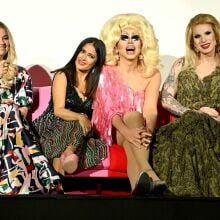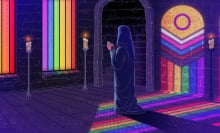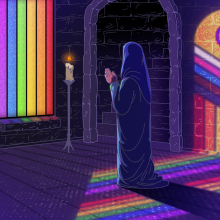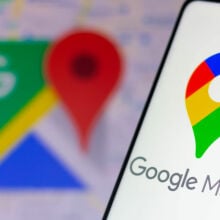We leave pieces of ourselves in every place we visit, every home we live in, and throughout all kinds of physical spaces. In the digital age, that permanence is heightened — there's an additional record of everything we've done or said to our captured, internet audience. That's often terrifying, but it's also powerful, especially for underrepresented groups who fight to bring overlooked stories to the fore.
Never has this been more relevant than now for LGBTQ communities, which have been habitually erased from mainstream history and face ongoing violating legislative efforts limiting their rights, visibility, and safety. Against this onslaught, the internet might be able to offer a counternarrative, led by the individuals, nonprofits, and scholars documenting and mapping queer existence.
Digitizing everyday LGBTQ history
Mapping the Gay Guides is a historical database and mapping of LGBTQ spaces based on the midcentury gay-friendly travel guides created by Bob Damron, a businessman who kept track of his experiences as a gay man traveling around the United States from the 1960s on. Damron decided to systematize and sell his observations, similar to the historic "Green Book" created in 1936 to help Black travelers find safe spaces around the United States, and in doing so compiled one of the largest and longest studies of this facet of queer culture from 1965 to 1980.
In the 1980s, Damron sold his solo idea to Dan Delbex to start the Damron Company, and updated Damron Guides, led by writer, president, and editor in chief Gina Gatta, which were still being published as recently as 2020. You can purchase some of the original copies and more recent editions online, or find versions in digital libraries.
For more Social Good stories in your inbox, sign up for Mashable's Top Stories newsletter today.
In an interview with Los Angeles Magazine ahead of the 52nd (and possibly last) edition of the guide, Gatta mourned a slow decline in interest, saying she understood the books no longer appealed to young LGBTQ people, especially those in big, urban cities. But the internet may be able to give the guides yet another life — the inspiration behind today's digital resources.
The Mapping the Gay Guides website was created by Dr. Eric Gonzaba, assistant professor of American Studies at California State University, Fullerton, and Dr. Amanda Regan, an assistant professor in the department of history and geography at Clemson University. The idea to transition Damron's guides into a digital resource came as they were both defending their dissertations, one with a focus on queer history in the 20th century and the other on women and gender in the 20th century, at George Mason University. Gonzaba was using Damron's guides in his research into gay male nightlife post-Stonewall; Regan, a digital historian who created software for fellow scholars, agreed there was potential to do more with the guides, as well as preserve a kind of oral history that is easily forgotten or erased.

Damron's weren't the only resources of their kind, with others like the Gayellow Pages and Spartacus Guides offering similar information, and the Damron Guides aren't free of problems, as early guides were limited by the mainly white male audience, Gonzaba noted.
"Damron did not think of himself as an activist," he explained. "He thinks of himself [as] a businessman at heart." But the guides uniquely show how physical spaces among the LGBTQ community have evolved over time, the beautiful complexity in queer activity and pastimes, and how this history is more universal than we have been led to believe.
"I wanted people to have a communal resource that's forever changing and growing and evolving. And I thought of a map."
There are hundreds of thousands of entries that Regan, Gonzaba, and their team have to map (and that's just up to the 2005 guides, with help from a National Endowment for the Humanities grant), in a simple effort to increase this knowledge pool for scholars and the general public alike. "One of the things that we talk about in the field is the way digital history has the potential to democratize history," Regan said. "But it also has the potential to recover lost voices. And that's really what we're trying to do here...to recover these voices and make a really simple argument that LGBTQ history is everywhere."
Tweet may have been deleted
Gonzaba added that there's a cultural misconception that queer history and culture is contained to large, metropolitan areas — the places you most often see in historic images or history books, if they're included. "So many people think queer history is stuck in the streets of New York and San Francisco. By having a database showing that gay bars existed in my home state of Indiana, or Kentucky, or in Idaho, you really refute the idea that gay history is only this mega metropolis, urban phenomenon." This history has permeated all spaces and is, importantly, continuing to influence present-day existence.
Empowerment through modern mapping
Everywhere Is Queer is a more modern adaptation of Damron's idea, as it documents queer-owned businesses around the world fully sourced from the experiences and spirit of the LGBTQ community itself. It was conceptualized, built, and is still maintained by just one person, Charlie Sprinkman, a Bend, Oregon-based 26-year-old who got the Damron-esque idea while traveling around the country working with an organic beverage company in 2019. Sprinkman, a former entrepreneurship and global environmental sustainability major, was inspired by his own need to find queer spaces across 42 states. Then, in 2021, Sprinkman found the final mapping spark while working for Camp Brave Trails, a LGBTQ leadership camp based in California.
"I really just felt this euphoric community of like 100 queer people for a week, that I've never felt before," he reflected. "Driving back to Colorado, I was like, 'How can I create this feeling for other people?' I wanted people to have a communal resource that's forever changing and growing and evolving," Sprinkman said. "And I thought of a map."
After soft-launching the site with no listed businesses and a collective hope in January 2022, Sprinkman has seen immense online traffic to his map, with hundreds of businesses added and more than 500,000 site views in its first year. He wanted it to be entirely a communal effort, nurtured by the site's casual, organic growth — any business can register their location using a Google form on the site or in the bio on its Instagram, and Sprinkman verifies them on an honor system.
Businesses don't have to be brick and mortar stores, either, he says, encouraging online shops, freelancers, artists, and performers to add themselves to the site and make an even more encompassing mapping of queer endeavors. On top of the digital map, Everywhere Is Queer also hosts an active job board for the businesses and site visitors to network and fill open positions at queer-owned places.
The map garnered media attention and the ever-important TikTok buzz in 2022, when OpenlyNews, a popular TikTok account sharing queer news from around the world now followed by nearly 200,000 users, highlighted the website in a post that April.

Sprinkman isn't alone in thinking of maps and databases to help connect LGBTQ communities. There are several other mapping initiatives in the works, including more specific identity "maps" like the Lavender Book, a community-made database of safe spaces for Black queer, trans, and nonbinary people around the country. The site was created in 2021 by the National Black Justice Coalition, a civil rights organization advocating for the Black LGBTQ community, and Out in Tech, a nonprofit that supports LGBTQ tech leaders.
These kinds of maps have tangible effects in the real world beyond the very important documentation of history. They build safer spaces for queer existence and foster essential relationships that have personal, social, and even economic repercussions. Sprinkman explained that his map has allowed LGBTQ people to find and connect with each other in their own hometowns after believing they were all alone. "We have 28 queer-owned businesses here in Bend. I talked to people that have lived here for 15 years and were like, 'I had no idea that there were this many queer-owned businesses!'"
Maps as community storytelling
The present-day effect of Sprinkman's mapping and the historic work of Gonzaba and Regan are connected. "You see stories written by the press almost every year, especially around this time of year during June, asking 'Is the gay community divided?' Or, 'Are gay spaces evaporating?'" Gonzaba said. "I think to answer the question today, we have to look back. What role did queer spaces have historically on our community? Are those roles being met now, by other spaces? Is there not a need by the community? What has changed?"
Other digital mapping initiatives have responded to this need for answers, for community, and for accessible queer histories in uniquely creative ways. For instance, Queering the Map, a crowdsourced platform of anonymous queer experiences around the world, invites LGBTQ people to add their own personal experiences to the global map — things like first kisses, queer parties, and places of self-discovery. Reading it, you'll stumble upon pieces of history besides stories of joy and humor, attached to the geographical spots where the events happened:
"SF General Hospital. In Ward 86 anyone with HIV could get high-quality treatment. We learned about giving people love at the end of their lives. So many friends left the earth here during the '80s."
In Michigan, you can read through an entire personal history:
"April 2015, I finally came out, and ran from here to find a real family who'd love me for me. I succeeded, I got a job and a degree in Grand Rapids, I made some other trans friends, and I'm getting married soon!"
Abroad, you'll find even more, like the story of a young person in Turkey's first queer experience:
"This is the place where I went to the third base with a girl for the first time, a small garden of orange trees near my old middle school. We had a picnic and drank. When it got dark, we sang 'yıldızların altında' together and kissed. It was short-lived though, my parents called me home and sent my brother to look for me…"
Or across the water in England:
"we sat and played minecraft in a tent here. i wonder if you'd still love me now im a boy? do you even know? did you then?"
 Queering the Map gives the global LGBTQ community a digital fingerprint. Credit: Queering the Map
Queering the Map gives the global LGBTQ community a digital fingerprint. Credit: Queering the Map
The site's purpose doesn't necessarily have a quantifiable effect, like guiding people to businesses or physical safe spaces, but it's still documenting a modern queer history that serves to metaphorically tattoo these identities on the physical locations where we live, work, and travel. It's forging community, and building a common empathy, through the human act of documenting everyday moments.
As politicians vie for control over the lives of members of LGBTQ communities around the country, their targets are fighting for the right to exist in schools, in workplaces, in their own bodies, and, importantly, in the historical record. Many are simply begging for the chance to say, "I was there. That was me. That is how I lived." These digital maps, from the informal to the academic and historic to creative, might help them do so.
"I really love to think about our youth and what this opportunity can provide in this major technology world that we're living in now," Sprinkman said. "If you're reading this article, and you're not out, know that there are millions of us that see you. Your feelings are so valid. And I hope that in time you can come to terms with everything. One of these spaces will hopefully help that."
Originally published in June 2022, this story was updated in June 2023.
Topics LGBTQ Social Good





















